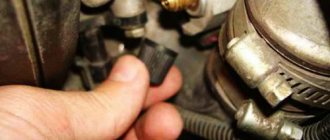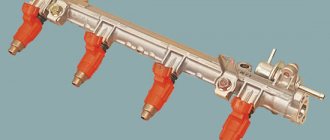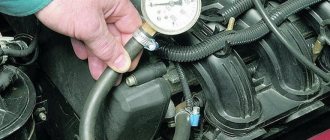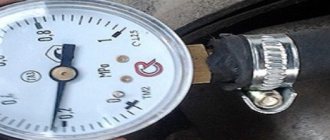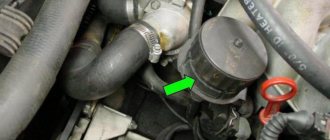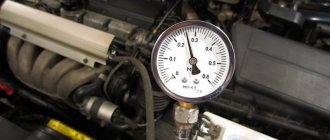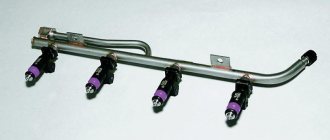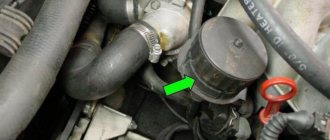Fuel pressure is an important parameter that must be constantly monitored. Its value directly affects the efficiency of the motor, its power and behavior in various modes. Consequently, every car owner who cares about the technical condition of his own car should periodically check the pressure. How to do this, read further in the article.
Fuel injector rail
The fuel rail (rail) is a mandatory element of the fuel system of an internal combustion engine with distributed injection. It is a section of a hollow tube, the ends of which are closed on both sides and are distinguished by the presence of bends for connecting tubes of smaller diameter. Through these tubes, fuel flows to the nozzles that are located on it. In addition, there is a pressure regulator on it. The fuel that enters the ramp is moved through injectors into the intake pipe. In addition to the outlet pipes, this design also contains a shut-off fitting and a hole.
How to check the pressure in the fuel rail, methods of checking
This parameter can be measured using several methods. One of the most common is the purchase of a special kit, which includes a special adapter for connection, a pressure gauge (it is thanks to this that the measurement is carried out) and a drain. You will have to allocate approximately 1,500 rubles to purchase these devices. But you can do it differently - go to a service station, where specialists cost 300-500 rubles. will carry out the required measurements.
However, there is a more sophisticated method that does not require additional costs - you can measure fuel pressure using an ordinary pressure gauge used to check tire pressure. In this case, it is advisable to use pressure gauges for measurements, the limit of which is minimal (about 6-7 atmospheres). This will reduce the error to a minimum.
Replacement
The procedure for replacing the fuel pressure regulator on a car like the VAZ 2110 cannot be called complicated. Therefore, do not rush to go to a service station to pay a decent amount of money. Moreover, if this is a dubious car service, it is far from a fact that they will perform the repair better than you can do it yourself.
One way or another, every VAZ 2110 car owner should know about the sequence of replacing the fuel sensor.
For this:
- Relieve the load in the fuel system;
- Remove the return mount from the fuel pressure regulator, remove the pipe;
- Unscrew the two bolts responsible for securing the unit;
- Remove the fitting;
- Remove the gasoline hose from the fuel pressure regulator;
- Remove the failed fuel sensor;
- Place a new device in its place;
- During the reassembly process, it is recommended to change the old cuffs. After their dismantling, they usually lose their original working conditions. Therefore, reusing them will not allow them to function as before.
Obviously, the fuel pressure sensor plays a vital role in the functioning of the VAZ 2110, like any other car. Its condition should be treated with increased attention, promptly respond to changes occurring, and take appropriate measures if the regulator fails.
It’s not difficult to do it yourself, and you’ll have to spend quite a bit of money. But if you are not confident in your abilities, you have no desire or simply no time to work on your own car, go to a proven, reliable car service, the quality of whose services you can be confident in. We do not recommend contacting any dubious workshops.
5. Use a 14 mm open-end wrench to tighten the hose tip.
RECOMMENDATION If necessary, the pressure in the fuel rail can be measured with a homemade device, made from a pressure gauge from a foot pump. Before connecting such a pressure gauge, the fuel pressure must be relieved (see Fuel Line - Pressure Relief). After this, unscrew the spool from the fuel rail fitting. This can be done with a metal wheel valve cap. To connect the pressure gauge to the fuel rail fitting, use a piece of gas-resistant hose of suitable diameter. The ends of the hoses must be securely secured with clamps.
6. Turn on the ignition on the car. The fuel pump will run for a few seconds. After waiting until the pump stops working, turn off the ignition. 7. To remove air from the pressure gauge, lower the end of the drain tube into a small container, unscrew the pressure gauge bleeder fitting 1/3-1/2 turn, and release excess gasoline pressure from the fuel rail. This will remove air from the pressure gauge hose.
On the VAZ 2110, the fuel pressure regulator is designed to maintain constant pressure in the fuel system in any operating mode.
The RTD is a diaphragm valve that is installed in the fuel rail. On one side, gasoline pressure is exerted on it, on the other, springs and air from the intake manifold.
How to check the fuel pressure of a VAZ 2110 1.6 engine without return flow, check diagram (step by step)
On a VAZ 2110 with a volume of 1.6, the pressure indicators in the fuel rail are unchanged and vary between 3.6-4 bars. In this case, measurements are often carried out according to the same principles as described above. However, there are several other non-standard methods.
- We prepare the above-described structure - a hose at the end with a pressure gauge.
- The diameter of the hose should be approximately 8 millimeters.
- Measurements are taken at the outlet of the fuel pump module.
- The normal parameter is considered to be a pressure of 5-7 atmospheres.
- Remember how the return line is closed on engines with a drain ramp. In this case, it is better to turn off directly at the fuel pump.
- The double hose should be dismantled and a plug inserted (instead of the plug, you can use a “nipple” from the fuel filter).
- Pull the single pipe onto the pump fitting. Measurements are taken directly on the ramp.
It is important to remember that problems with the fuel system, as a rule, manifest themselves as sudden “dips” when reaching high engine speeds. In addition, when driving, the car can jerk, it stalls when accelerating, and so on. In this case, you need to check the pressure. Only after this can the main causes of the problems be discovered - the fuel pump, injectors, filters, and so on.
If the electrical circuit in a VAZ 2110-2112-2170 car is obviously in good working order, and the pump hums as usual, this does not mean that gasoline is supplied to the injectors as normal. No! There may be some problems here. Let's start with the most basic.
First, remove the protective cap of the fitting (as shown in photo 1), be sure to place a cloth underneath so as not to splash the engine compartment with fuel, and use the tip of a thin slotted screwdriver to press the spool of the fitting. If the stream of fuel is thin or weak, this means low pressure in the fuel rail; you need to look for the cause. If gasoline sprays with strong pressure, then there is hope that the pressure is within normal limits (2.8-3.2 bar), but to be sure, you need to measure it with a pressure gauge. At the service center this is done using fuel pressure gauges with adapters.
We will use a simple one from a tire pump. The only main thing is that the measurement limit is at least 4 bar. You will also need a part of a gas-resistant hose, the length of which should be 150 millimeters, the internal diameter of which should be 10-12 mm. , as well as 2 more clamps. Use the wheel valve cap to unscrew the spool valve from the fuel rail fitting. We put the pressure gauge hose on the fitting and tighten it with a clamp.
Troubleshooting
No pressure in the fuel rail? Causes:
- Clogged fuel filter;
- Clogged fuel pump filter;
- Fuel pump malfunction;
- Malfunction of the fuel pressure regulator (FPR). And with high blood pressure too.
If the pressure in the fuel rail gradually drops, the cause may be:
- leaking fuel pump connections;
- leaking injectors;
- fuel pump malfunction.
Let's check it like this. We clamp the leading rubber hose of the fuel rail:
- the pressure has become stable - the fuel module is leaking or the pump is faulty;
- the pressure drops - the injector(s) are leaking.
Checking the RTD. Connect the pressure gauge hose to the outlet fitting of the fuel pump and turn on the ignition:
- the pressure is low but stable - this means the RTD is faulty and is releasing pressure too intensely.
If the pressure in the fuel rail is within normal limits, we look for the causes of engine malfunctions elsewhere.
Keywords: power system Lada Granta | power supply system for Lada Kalina | power supply system for Lada Priora | power supply system for Lada Largus | 4x4 power system | power supply system for Lada Vesta | power system lada xray | Lada Granta engine | Lada Kalina engine | Lada Priora engine | Lada Largus engine | 4x4 engine | Lada Vesta engine | lada xray engine | Niva power system | Niva engine | universal article
13
4
The most common body type of Lada Granta FL has been determined
Interesting facts about the Lada Vesta family
Firmware for Lada Vesta radio (MMC) using a programmer/adapter
Proper sound insulation of Lada car fender liner (how to do and reviews)
Signs of breakdown
If for some reason the fuel pressure regulator does not perform its functions, then this can be understood by the following signs:
- The engine's operation has become unstable, it may begin to stall when idling, although it would seem that the fuel level is sufficient and all systems are in working order;
- The crankshaft at idle speed has increased or, conversely, decreased speed;
- The engine, as they say, “loses throttle response”;
- While driving, dips and jerks occur in a running engine;
- Gasoline consumption increases compared to what it was before;
- The content of CO and CH in the exhaust increases;
- The engine starts with difficulty. Although this property does not always appear.
If the regulator has become completely unusable, then an increase in fuel pressure is observed. Instead of the norm for the VAZ 2110, which ranges from 2.5 to 3.3 kg/cm2, it reaches 4 – 5 and even more.
Consequently, the fuel pump supplies more gasoline by volume, which is not completely burned, and overconsumption is guaranteed. Of course, such a regulator needs replacement, and the sooner the better.
If the fuel pressure regulator does not provide the required pressure, or simply does not hold, then the lack of fuel pressure leads to the fact that normal supply does not occur, and the VAZ 2110 “chokes” when you need to increase the speed.
In addition, the starter cannot quickly spin the engine; it has to be turned on many times.
ON-BOARD DIAGNOSTICS FOR FAULT DETECTION
A malfunction of the fuel system leads to a deviation in pressure in the fuel rail. As a result, the amount of fuel supplied to the cylinders differs from the calculated one, and the air-fuel mixture becomes depleted or enriched. In engine management systems with an oxygen sensor, the controller monitors the current composition of the air-fuel mixture.
If the air-fuel mixture deviates significantly from the desired value, the controller perceives this condition as a malfunction, and one of two fault codes is recorded in the controller’s memory:
- P0171 - fuel system too lean;
- P0172 - fuel system too rich.
Increased or decreased pressure in the fuel rail is just one of the reasons why codes P0171, P0172 can be recorded in the controller’s memory. The cause of a significant depletion or enrichment of the air-fuel mixture may be faulty mass air flow sensors, oxygen sensors, or injectors. Air leaks lead to an over-lean air-fuel mixture.
The fuel pressure value may be outside the permissible range, but the on-board diagnostics does not record anything. It’s a very real situation - on-board diagnostics are not omnipotent.
FLS
It is quite clear that we first learn about excessive consumption of gasoline by readings from the level sensor. However, sometimes the FLS also starts to lie, and then the true consumption cannot be known.
There may be a situation when you still have half a tank of gasoline, but the FLS says that the fuel is almost empty. That is, the flow sensor itself may confuse you, and before rushing to replace the regulator, make sure that the FLS is working properly, remember that the VAZ 2110 has problems with it very often.
If you notice that it is lying, the fuel sensor may need adjustment or even replacement.
Device
The regulator includes two cavities - fuel and vacuum. Inside the vacuum there is a membrane that reacts to the air pressure coming from the power unit. Inside the fuel cavity there is fuel under high pressure.
The force of fuel pressure is resisted by a valve device. If the pressure is excessively high, the excess is returned back through the relief means.
This is interesting: Where is the camshaft sensor on the VAZ 2109
Measuring pressure using improvised means
Homemade design for measuring pressure in the fuel rail using a conventional tire pressure gauge
It’s easy to measure the pressure using available tools; you just need to have a regular tire pressure gauge on hand (which is used to monitor tire pressure - approx.). All you have to do is follow our instructions exactly. We will tell you how to carry out this operation correctly, and what the correct pressure should be in the fuel rail of the VAZ-2112.
Messages 16
1 Topic by denisby4kov.77 2015-06-22 23:57:56
- denisby4kov.77
- New member
- Inactive
- Registration: 2015-06-22
- Messages: 6 Thanks : 0
Topic: no pressure in the fuel rail (filter, pump and regulator replaced)
Hello. Such a problem - I was driving and began to tune the engine. I got to the garage and that was it. It starts, just under the throttle it stalls. I made a mistake on the fuel pump, I bought a pump motor and a filter. everything has been replaced. the problem has not gone away. I suspect a pressure regulator. purchased and replaced. the same. on the fuel rail there is a fitting for a pressure meter - so, I press the nipple on the fitting, three drops splash from there and that’s it. I suspect the injectors. who can tell me what?
2 Reply from 7491cm3x 2015-06-23 04:45:36
- 7491cm3x
- Connoisseur
- Inactive
- From: Norilsk
- Registration: 2015-01-29
- Messages: 467 Thanks : 119
- Car: VAZ 2112 1.5l 16v
Re: no pressure in the fuel rail (filter, pump and regulator replaced)
Connect the pressure gauge, turn the ignition key and measure the pressure. I don’t remember how much there should be, but Google will help. If below normal, look for a leak. If the injectors are pouring so much pressure that the pressure drops below normal, you will hardly start the engine, because the spark plugs will be flooded to the very top. Is there a smell of gasoline anywhere? Has the fuel filter been changed recently? Mesh in the tank?
3 Reply from denisby4kov.77 2015-06-23 07:59:06
- denisby4kov.77
- New member
- Inactive
- Registration: 2015-06-22
- Messages: 6 Thanks : 0
Re: no pressure in the fuel rail (filter, pump and regulator replaced)
The fuel pump, mesh and filter are new + pressure regulator. After turning off the ignition, the sound is like a Kamaz is leaking excess air. from under the hood
4 Reply from v258 2015-06-23 12:46:02
- v258
- Participant
- Inactive
- From: Krasnodar region
- Registration: 2015-05-14
- Messages: 171 Thanks : 37
- Car: VAZ 2111, 1.5 8V
Re: no pressure in the fuel rail (filter, pump and regulator replaced)
5 Reply from kuler_78 2015-06-23 13:01:06 (2015-06-23 13:07:35 edited by kuler_78)
- cooler_78
- Experienced
- Inactive
- Registration: 2014-10-22
- Messages: 142 Thanks : 57
Re: no pressure in the fuel rail (filter, pump and regulator replaced)
And this is not clear yet. It seems like there was no pneumatic compressor on the top ten. Is it possible that this is poisoning gasoline? Author, check the fuel line carefully. There can be no miracles. Maybe the line itself is clogged somewhere. I’ve seen this happen. The fuel rail was completely clogged. Yes and until you check the pressure in the rail, it’s not worth changing everything. Maybe the reason is elsewhere. You decided that it was the fuel pump based on indirect signs. And the fact that you press the nipple and three drops of gasoline flows out is not an indicator. I have the same situation. and the problem here is in the fuel pump valve, but it works fine even without it, only the pressure immediately drops and does not start the first time.
How the regulator works
The fuel regulator ensures that the difference in influence on the membrane is maintained on both sides, that is, both cavities. Only under such conditions can the engine function normally.
The sensor serves to maintain pressure differences regardless of the current engine speed. Fuel injection will not be possible if the pressure in the manifold is equal to or greater than that in the injectors. Injectors are required to have higher pressures.
If everything works well, the following processes are observed:
- The vacuum in the suction cavity of the manifold is reduced during quiet operation;
- In response to this pressure, the fuel in the rail and its supply to the injectors increases.
Spark Plug Inspection
If the spark plugs are wet, then gasoline flows. Dry? In this case, you need to check the signal at the harness connector of the mechanical liquid or gas atomizer (injector) with a probe (as shown in photo 6).
Did you do it, but the spark plugs are still dry? Then you will have to unscrew the screws securing the ramp and lift it under the intake manifold so that the injector nozzles can be seen. We turn on the ignition and turn the engine crankshaft with the starter. If there are no streams of fuel, you need to remove the injectors and most likely replace them with new ones. True, almost every serious service will recommend that you wash them.
If the price of a new set of injectors is slightly higher than flushing, then you should choose a replacement. Injectors also experience age-related problems. Also read:
Cleaning the fuel pump mesh
We take the fuel pump out of the tank, remove the screen and wash it. Before installing the fuel pump, it would be a good idea to check it for leaks and the reliability of the connection of its tube (arrow in photo 5) to the fuel line.
You will certainly ask what to do if the supply line is clean, the pump is humming, and the pressure is still below normal. In this case, you need to change the pump itself - it has exhausted its service life! Or it may happen that the pump seems to be functioning normally, but there is no pressure in the rail! This can happen in winter if there is a lot of water at the bottom of the fuel tank. When the grid freezes, it interrupts the flow of fuel to it. What should I do? Lighting a fire under a gas tank, heating it with a blowtorch or some other source of fire - this should not be done under any circumstances. It is preferable to remove the fuel pump and clear it of ice. The second option is for those in no hurry: roll the car into a warm room and wait... Then it would be a good idea to drain the water from the fuel tank. It's a troublesome task, but a rewarding one.
